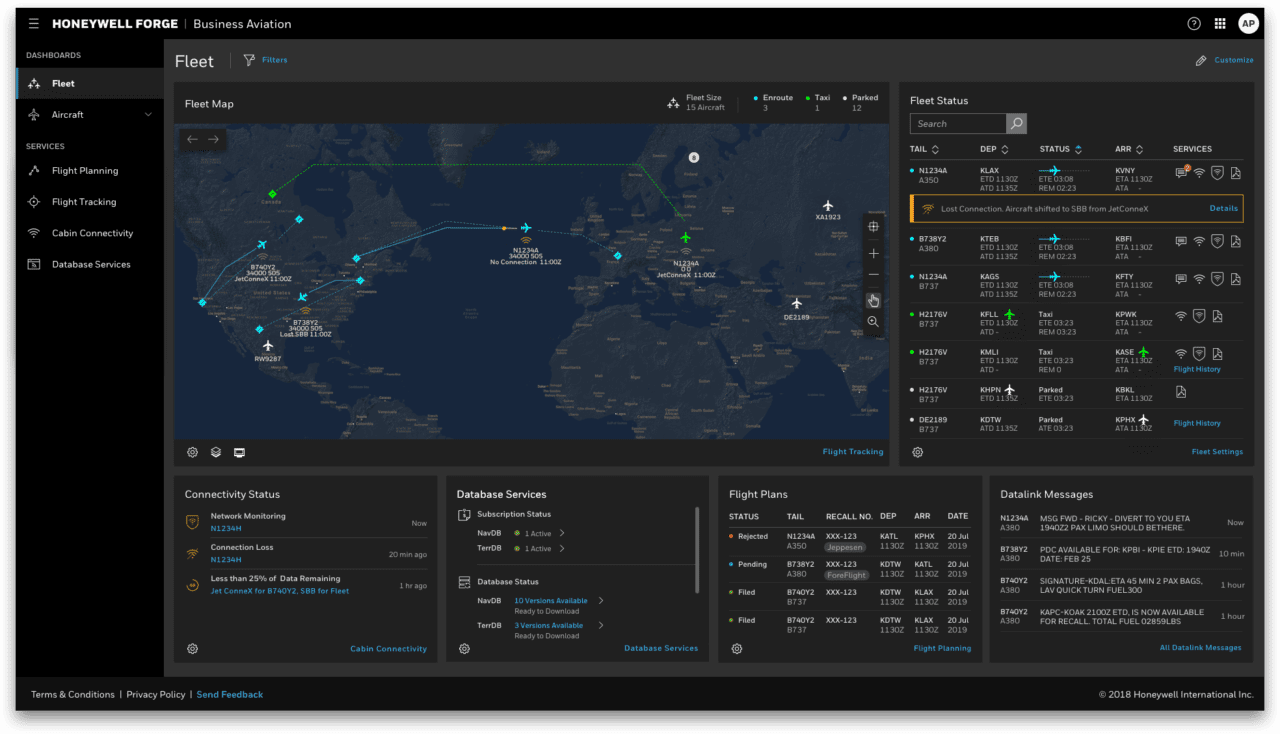
The fleet view on the Honeywell Forge dashboard displays a business aircraft fleet and enabled services. Photo: Honeywell Aerospace
Honeywell officially launched its Honeywell Forge technology stack and integrated dashboard for business aviation on March 17 to improve in-flight connectivity, flight operations, navigation, and aircraft maintenance for operators.
“We took Forge for business aviation, which is replacing Forge GoDirect, live to market yesterday,” John Peterson, vice president and general manager of the software and services division at Honeywell Connected Enterprise, told reporters in a March 11 teleconference. “We’ve had hundreds of users, all these aircraft, come online. We’ve got incredible feedback already.”
Peterson said that Honeywell plans “to grow and develop” Forge for business aviation “rapidly over the next 90 days” through software releases every six to 12 weeks to bring in more capabilities and integration “so that operators can get rid of those needling tasks that consume their time and don’t really help them do their jobs.”
“We’re going to automate those sorts of things,” Peterson said.
The Forge dashboard is to provide real-time alerts and suggested courses of action so operators can address connectivity issues, changes in flight plans and navigation database availability, and maintenance events.

The dashboard here shows a real-time look at the status of in-flight connectivity availability on a business jet in real-time including how much data applications used by individual passengers are consuming. Photo: Honeywell Aerospace
Forge for business aircraft follows last June’s launch of Honeywell Forge for airlines to save airlines up to $200,000 per aircraft per year in fuel costs and up to $40,000 per aircraft per year in maintenance costs. Honeywell executives discussed that program in an Avionics International industry webinar last November, “The Connected Aircraft: Creating a Node for Maximum Optimization.” For business and general aviation aircraft, Honeywell said that Forge can lead to savings of more than $100,000 per aircraft per year.
The Honeywell Forge technology stack is capable of collecting, cleaning and analyzing wide swaths of data from a variety of airline sources for predictive analytics. The integrated software solution combines a range of individual aircraft and overall airline data into a dashboard that users can customize.
Honeywell Forge for business aircraft replaces GoDirect, which the company rolled out in 2016 for those aircraft.
“We really wanted to do something different in business aviation,” Peterson said of the GoDirect launch. “We did that with our inform and control message. We brought a whole different value proposition to operators in the market where we were giving them the information they always wanted but never had on how their services were doing. We were giving them alerts to ensure that they didn’t break their budgets and tools that gave them control over their services so now what happened was they could get into lower cost services or control the types of services that went into the aircraft. We have saved operators hundreds of thousands of dollars per year, just by putting the information in their hands and giving them control over their services.”
Feedback on GoDirect from customers and Honeywell’s examination of its activities in airline, defense, and other markets led to Honeywell’s development of Forge for business aircraft, Peterson said. Honeywell found that business aviation customers wanted a new product to bring in such features as flight scheduling and flight planning to present an integrated, situational landscape for aircraft operators.
“We’re putting together the software APIs [Application Programming Interfaces],” Peterson said. “We built this incredible enterprise software stack that we’re applying in the airlines market and the defense market, and now we’ve found the right place to apply it in the business aviation market.”
Steve Knox, crew chief for the Honeywell aircraft fleet, said that his staff “used to have two monitors, a laptop, and a smart phone just to keep track of the aircraft fleet, the schedules, the weather and our data linking.”
 | Want to hear more on aircraft connectivity applications? Check out the Global Connected Aircraft Podcast, where Avionics editor-in-chief Woodrow Bellamy III interviews airlines and industry influencers on how they’re applying connectivity solutions. |
“Now since Forge came out, everything is combined onto one monitor, which is great,” he said. “When our aircraft are at home base, the data base service tile is extremely helpful in determining when the data base is going to run out, which ones are due at a glance. It helps planning when to load or update them. This takes planning because charts take one hour; navigation will take 20 minutes, and the enhanced ground proximity warning systems take one to two hours so we need a five hour block in order to update these.”
Knox said that two of the most frequently used tiles are the fleet status and map with weather overlay tiles.
The map with weather overlay, fleet aircraft positions “at a single glance,” and Wi-Fi connectivity are “great tools to tell me where everyone is and who’s up and running already,” he said. “It quickly shows weather en route or at airports that would affect our departure or landing times. When flat connectivity loss issues come up, I simply click on the Ka or [Inmarsat] SwiftBroadband overlay to see if they’re flying thru a satcom beam that might be currently out or switching beams.”